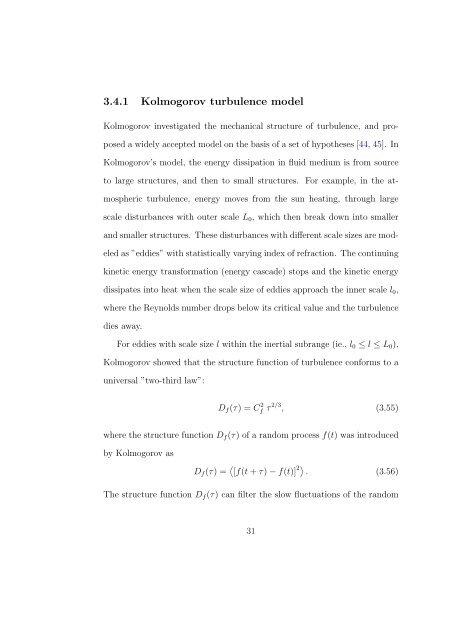OPTIMAL BEAM FORMING FOR LASER BEAM PROPAGATION ...
OPTIMAL BEAM FORMING FOR LASER BEAM PROPAGATION ...
OPTIMAL BEAM FORMING FOR LASER BEAM PROPAGATION ...
You also want an ePaper? Increase the reach of your titles
YUMPU automatically turns print PDFs into web optimized ePapers that Google loves.
3.4.1 Kolmogorov turbulence modelKolmogorov investigated the mechanical structure of turbulence, and proposeda widely accepted model on the basis of a set of hypotheses [44, 45]. InKolmogorov’s model, the energy dissipation in fluid medium is from sourceto large structures, and then to small structures. For example, in the atmosphericturbulence, energy moves from the sun heating, through largescale disturbances with outer scale L 0 , which then break down into smallerand smaller structures. These disturbances with different scale sizes are modeledas ”eddies” with statistically varying index of refraction. The continuingkinetic energy transformation (energy cascade) stops and the kinetic energydissipates into heat when the scale size of eddies approach the inner scale l 0 ,where the Reynolds number drops below its critical value and the turbulencedies away.For eddies with scale size l within the inertial subrange (ie., l 0 ≤ l ≤ L 0 ),Kolmogorov showed that the structure function of turbulence conforms to auniversal ”two-third law”:D f (τ) = C 2 f τ 2/3 , (3.55)where the structure function D f (τ) of a random process f(t) was introducedby Kolmogorov asD f (τ) = 〈 [f(t + τ) − f(t)] 2〉 . (3.56)The structure function D f (τ) can filter the slow fluctuations of the random31
















